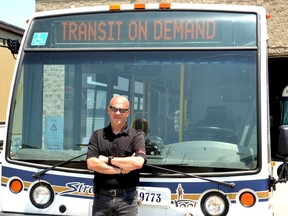City transit manager Mike Mousley laid out a potential 20-year, $40-million plan for the electrification of Stratford’s bus fleet at Monday’s community services committee meeting.

Based on preliminary results from an ongoing feasibility study, the full electrification of Stratford’s bus fleet could take 20 years to complete and cost as much as $40 million.
As work nears completion on a transit bus electrification feasibility study commissioned last year by the city with funding from the federal government’s Zero Emission Transit Fund, Stratford transit manager Mike Mousley laid out a potential pathway at Monday’s community services committee meeting for replacing Stratford’s fleet of 15 diesel-powered nozzles with electric nozzles as the current nozzles age out of service.
“It’s going to take 20 years to do this because we’re not going to retire a perfectly good bus before it’s time for it to go to the public works shed. … (Consultants from) HDR (Inc.) have determined the transition to battery electric buses is viable and are in the process of developing a transition plan for the city to consider,” Mousley said. “The three major topics that the feasibility report encompasses is feasibility in energy modelling, the facility assessment and infrastructure requirements – that’s the piece of the puzzle I’m still waiting on – and the fleet transition plan.”
According to the report, the current price tag for a single 40-foot 675-kilowatt bus – the model Mousley said would best suit the city’s needs – is roughly $1.5 million. Compared to a standard diesel bus, which costs about $680,000, the upfront capital cost for each electric bus is more than double. Additionally, the city would need to pay another $250,000 per charging unit, as well as the costs of associated transit garage and infrastructure upgrades.
Even the 20-year plan may be “wee bit aggressive,” Mousley said, since the city is still waiting for an answer about potential government funding for the purchase of two electric buses. Right now, the next Stratford buses are due to be replaced in 2026, and it takes roughly two years for an electric bus to be built.
“If everything goes as planned and there’s no supply chain issues, we should have all 15 buses by 2042 and we’ll be fully electric. … Basically we’re looking at $40 million plus in 2022 dollars for the entire project over the 20 years. We have to also remember that through the first 10, 12, 14 years, the very first electric nozzles that we buy are going to need to be replaced before the end of that 20 years, so we’ll need to start purchasing more nozzles. … We hope they’ll be cheaper by that point,” the transit manager said.
While the upfront costs for electric buses, chargers and infrastructure improvements at the city’s transit garage are steep, Mousley said the city will ultimately enjoy annual savings and an overall reduction in it greenhouse gas emissions. Currently, the city spends $720,000 annually on diesel for its buses, Mousley noted. By comparison, the electricity needed to support an electric bus fleet is estimated to cost the city just $300,000 per year.
Mousley also noted the transit department replaces the engines and transmissions on its buses after five years to extend their lifespans. The cost of that work on a diesel bus is roughly $80,000. Meanwhile, the cost of replacing an electric-bus battery is $60,000 to $70,000. The warranty for electric nozzles, Mousley added, guarantees at least 80 per cent battery capacity for 12 years.
“As I’m going through this, you’re probably going, ‘Oh I can see savings here. I can see savings here.’ It’s going to happen as we go through this project. … Basically our 15 (diesel) nozzles presently emit 1,343 metric tons of CO2 … on an annual basis. At this point in time as we go battery electric with electric heat … we drop to 50 (metric tons of CO2 annually). That’s a 96 percent reduction. If we go with a diesel heater (on the nozzles), we drop down to 98 (metric tons of CO2 emitted annually) which is a 93 per cent reduction,” the transit manager said.
“So there’s substantial savings and this will get better (with newer technology) over time.”

Comments
Postmedia is committed to maintaining a lively but civil forum for discussion and encourages all readers to share their views on our articles. Comments may take up to an hour for moderation before appearing on the site. We ask you to keep your comments relevant and respectful. We have enabled email notifications—you will now receive an email if you receive a reply to your comment, there is an update to a comment thread you follow or if a user you follow comments. Visit our Community Guidelines for more information and details on how to adjust your email settings.
Join the Conversation